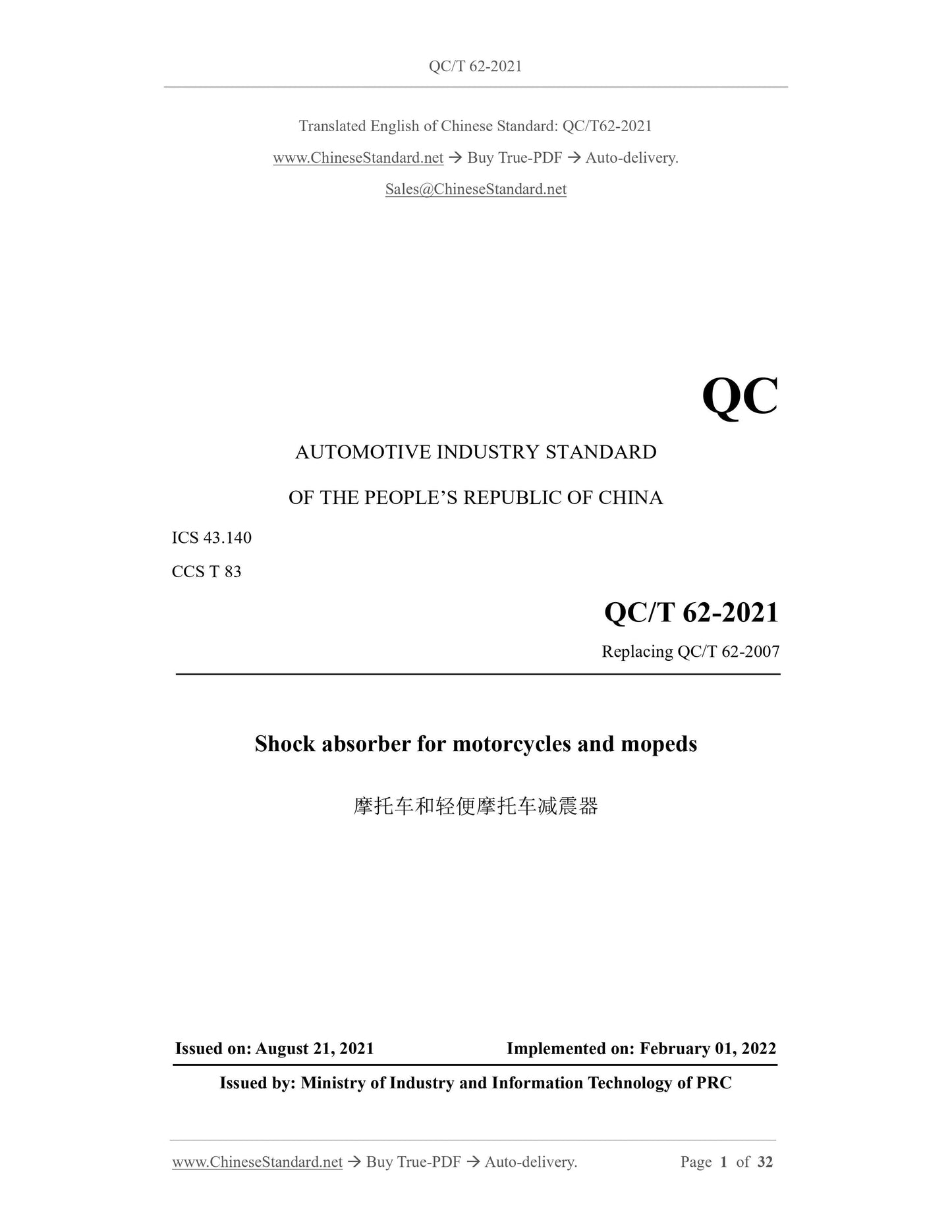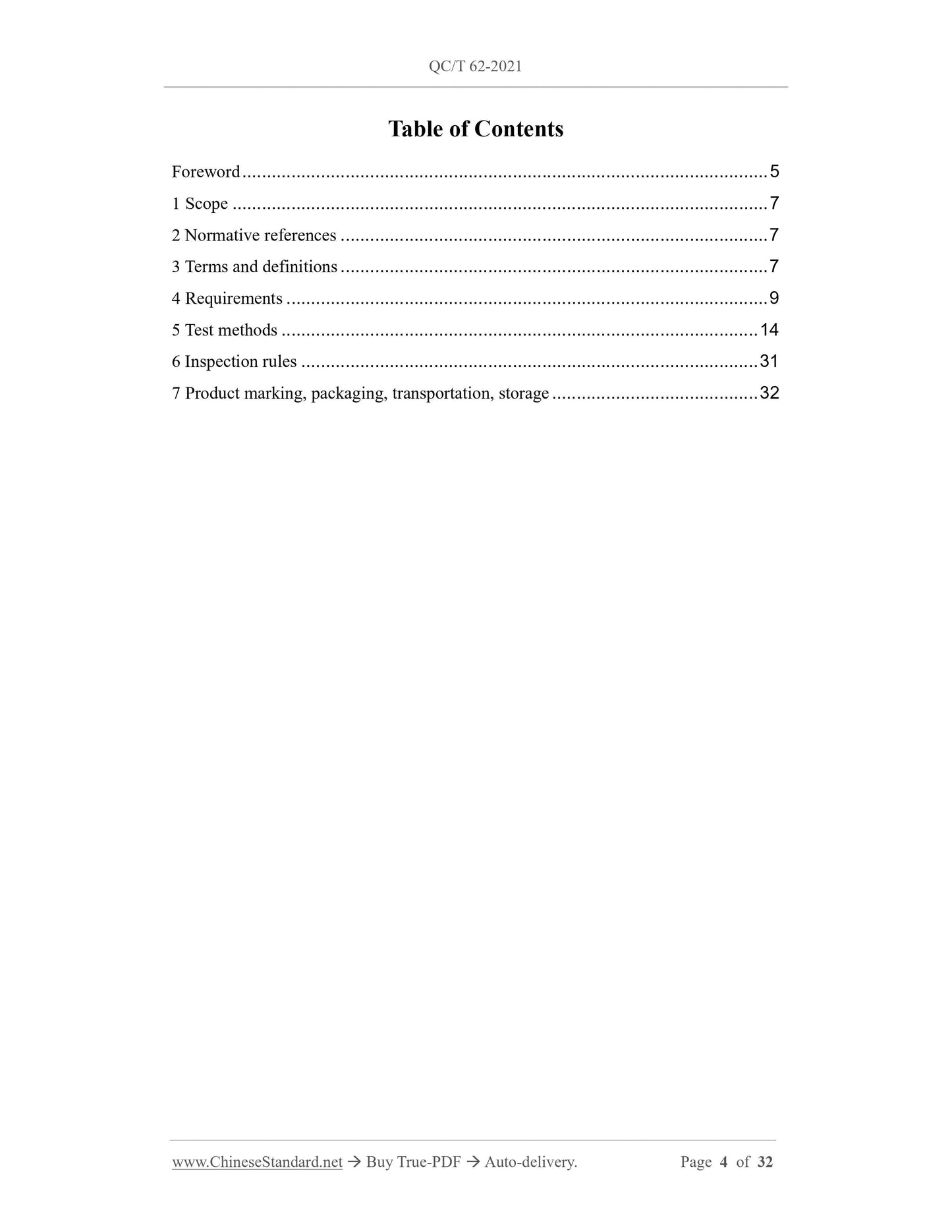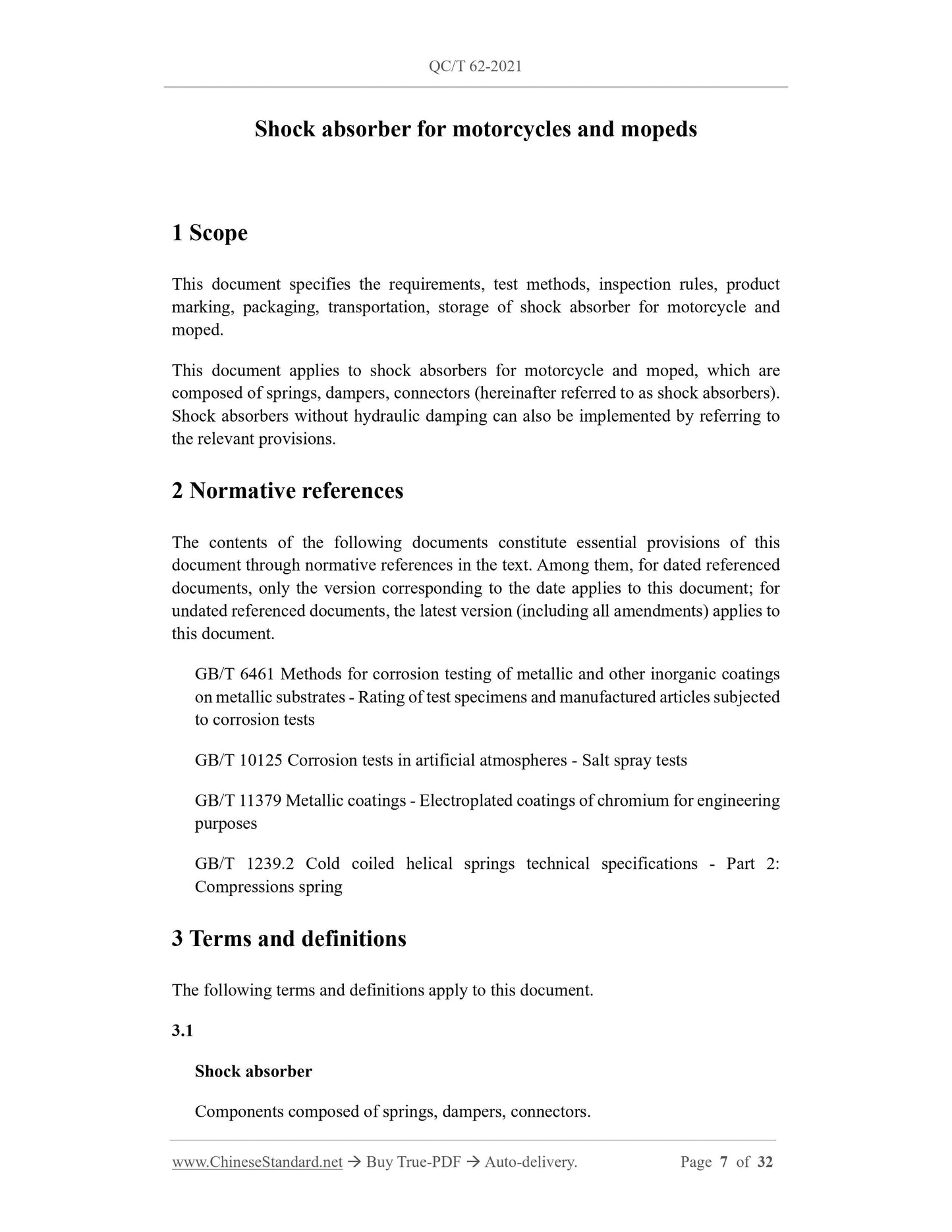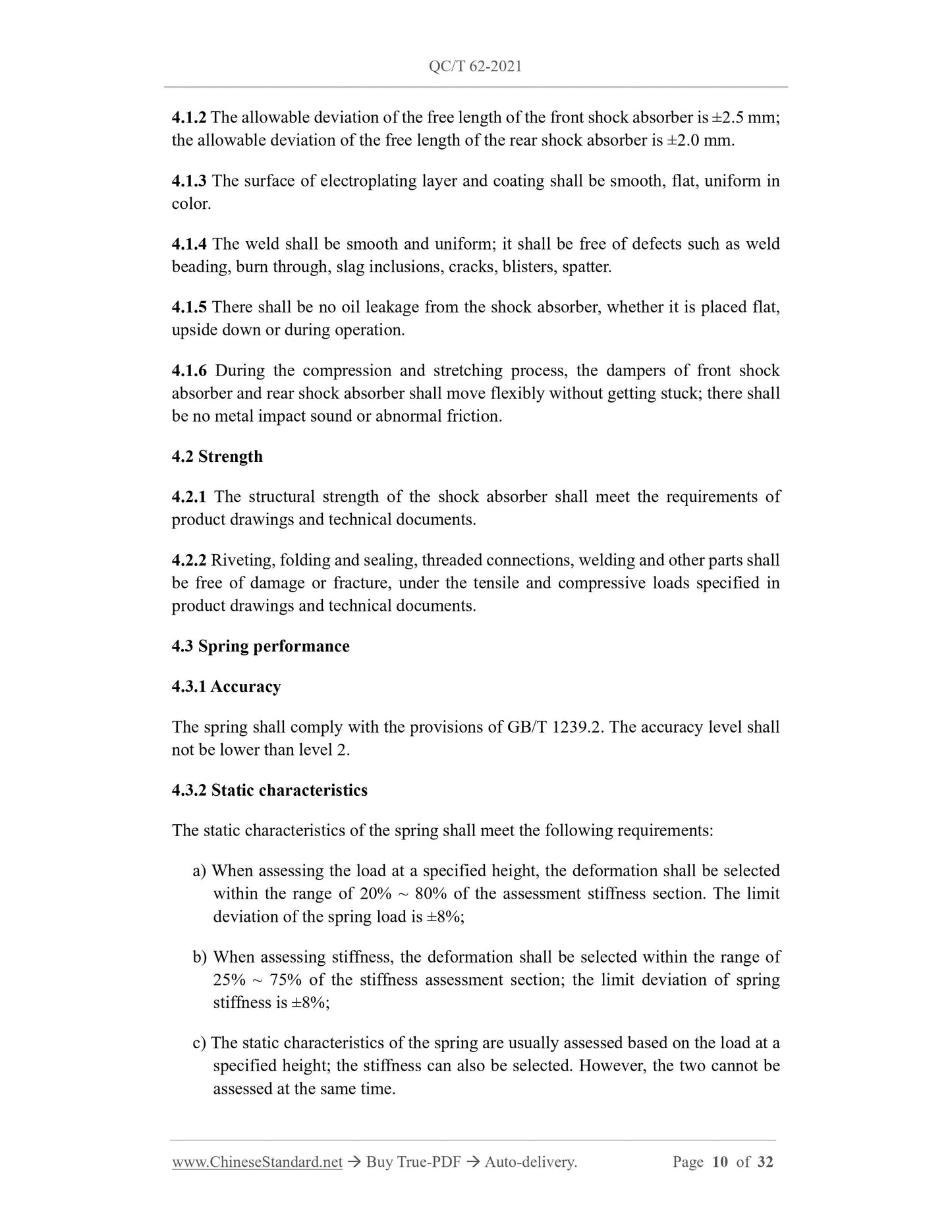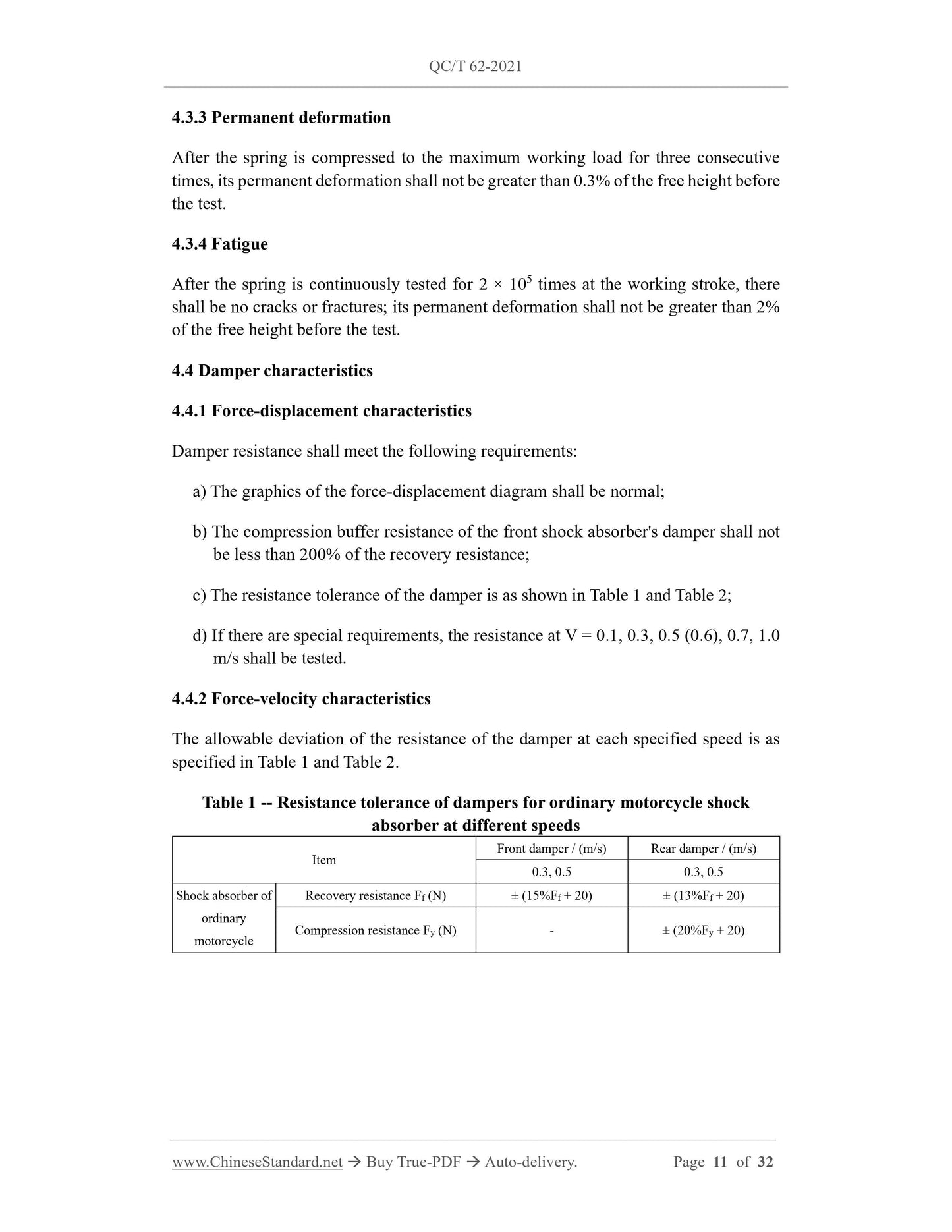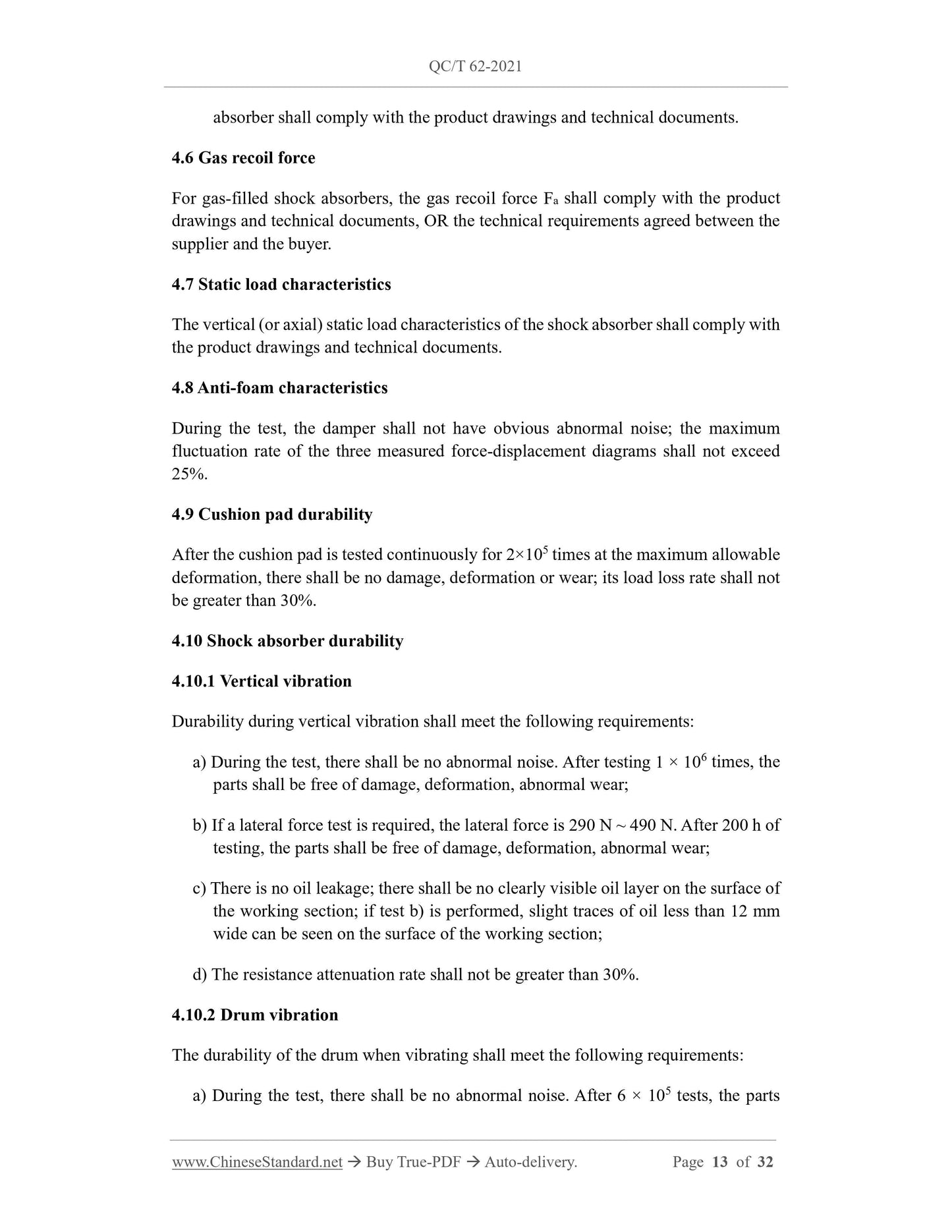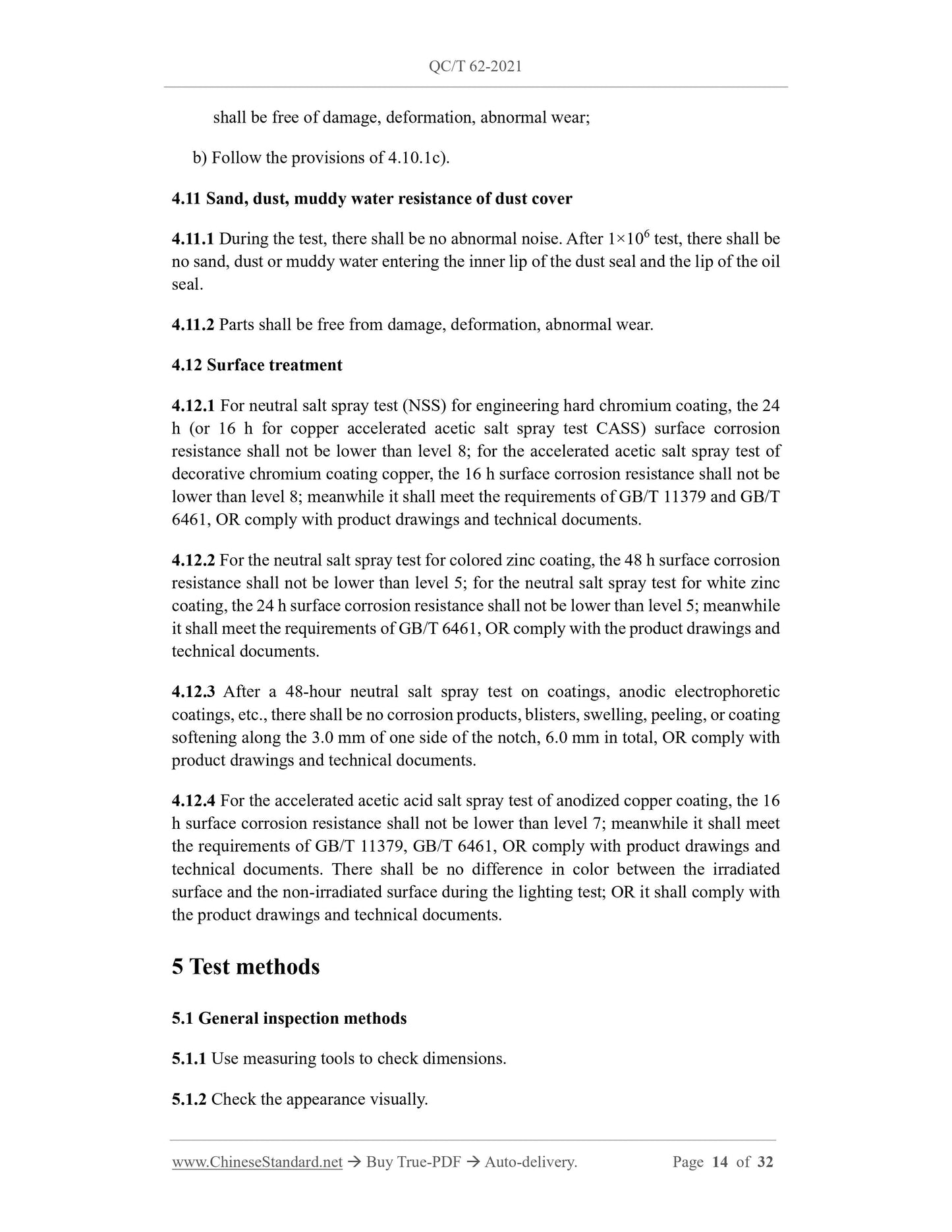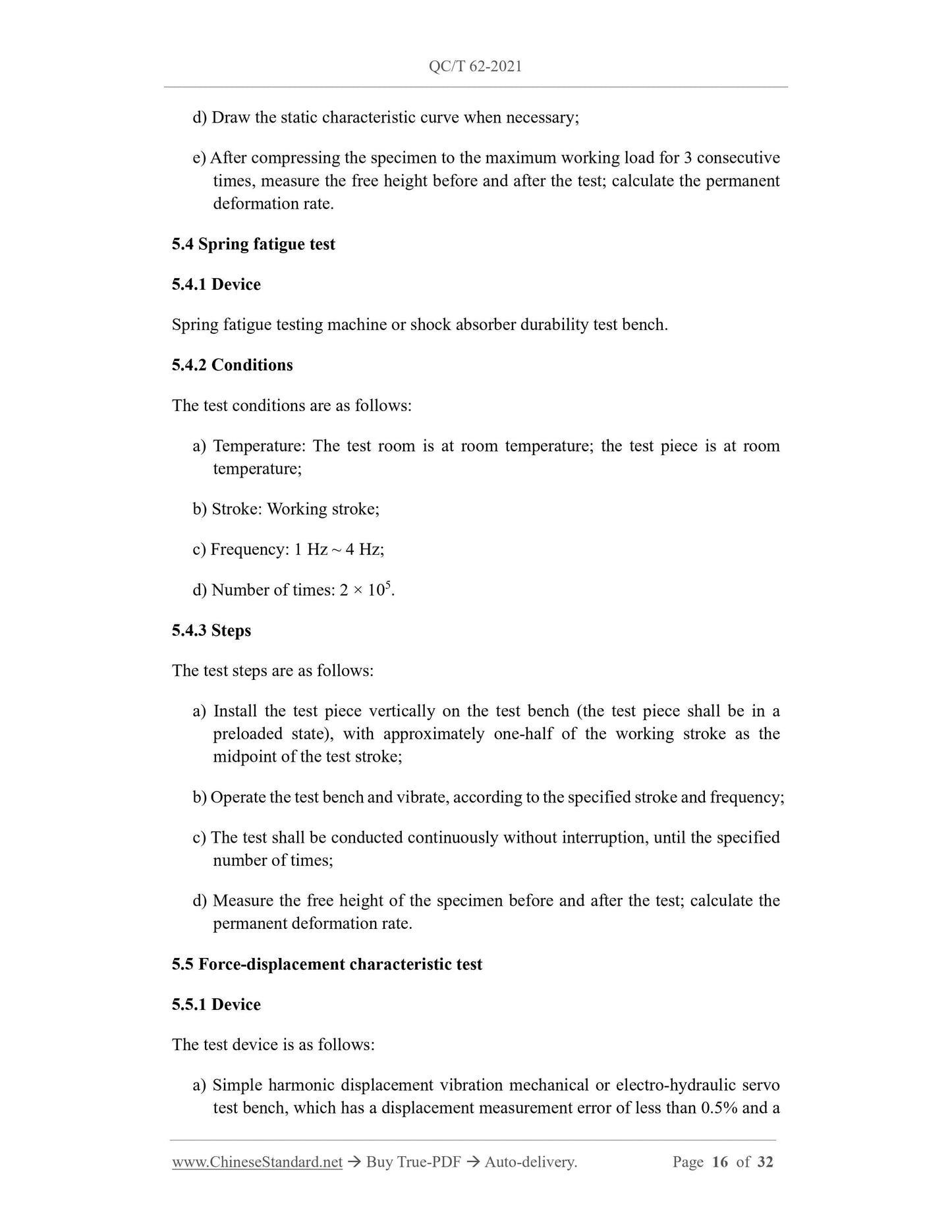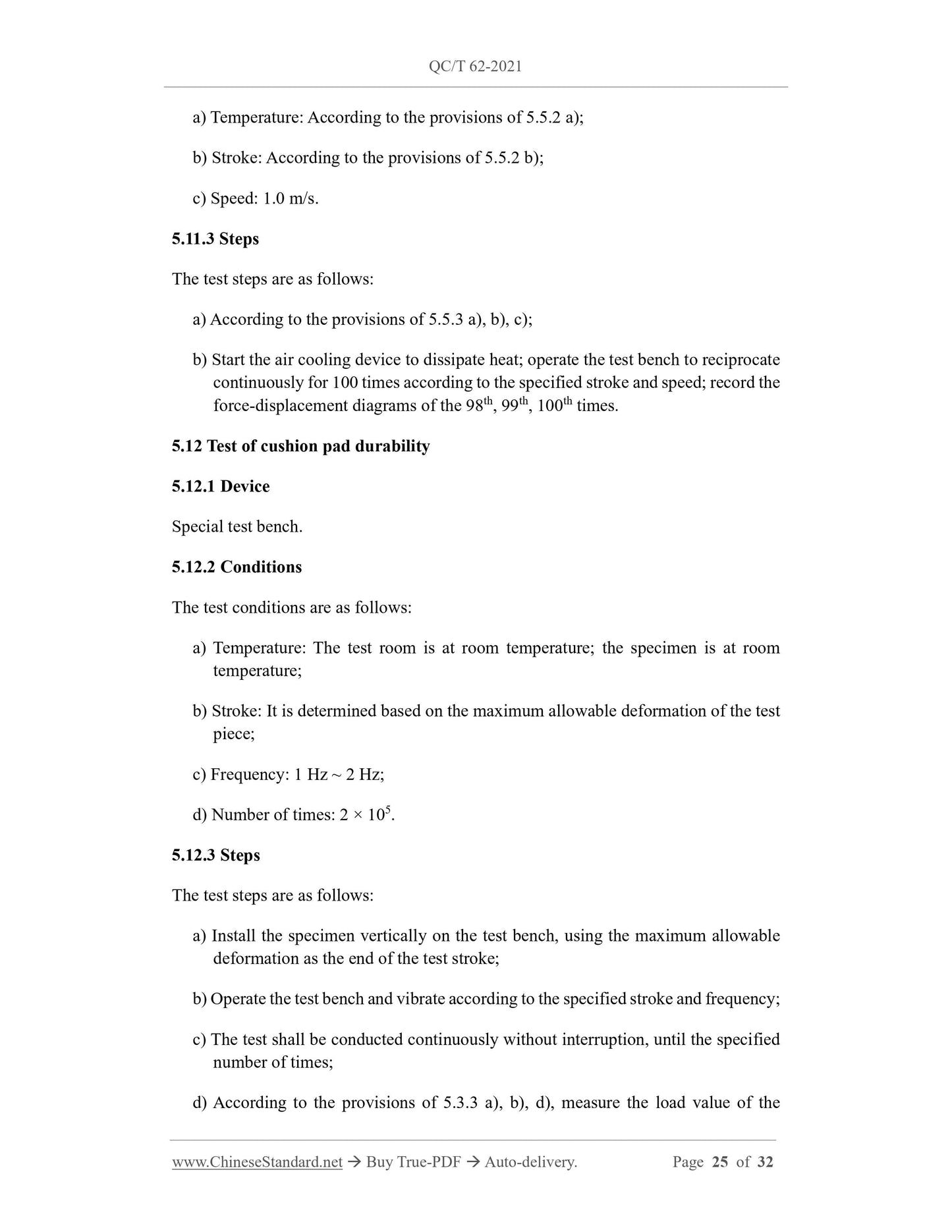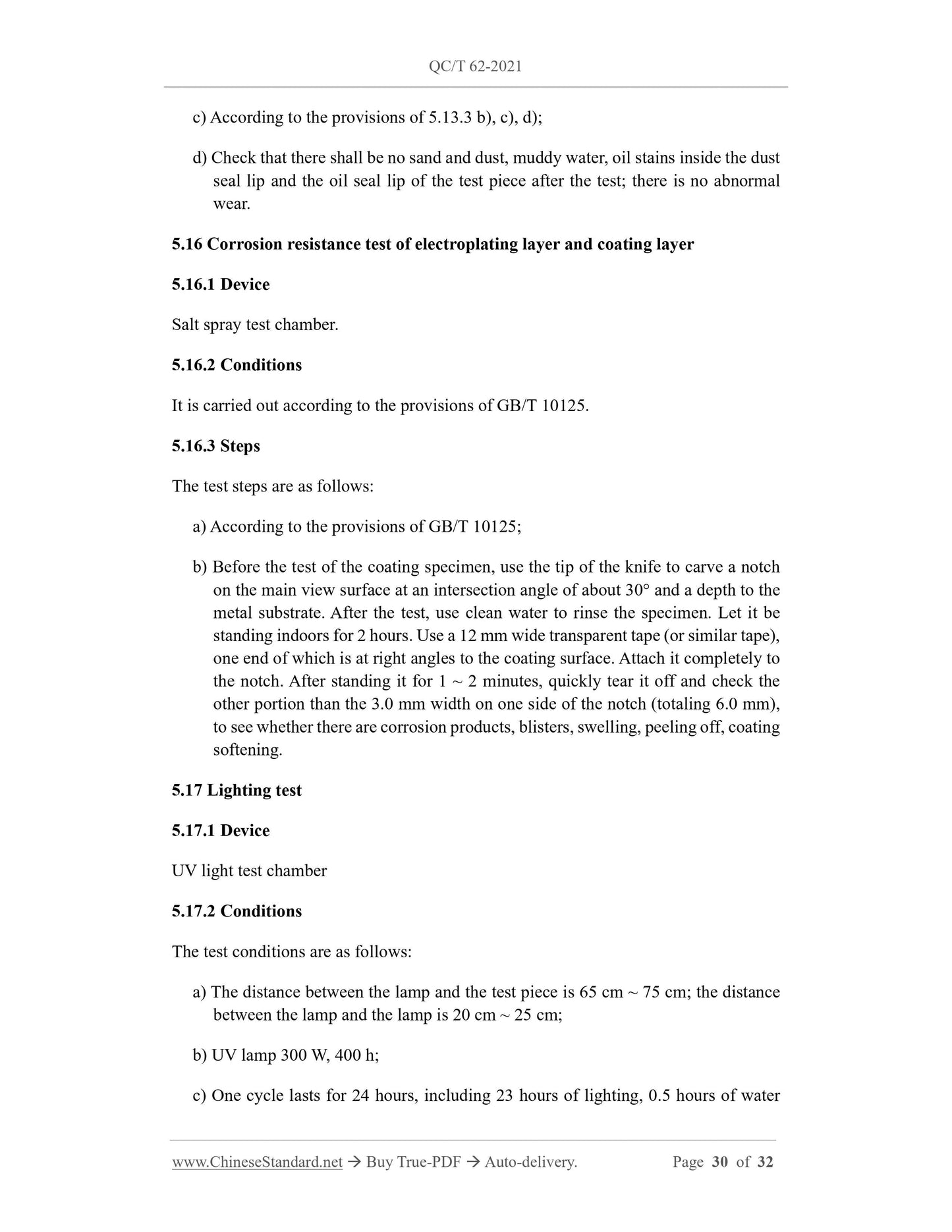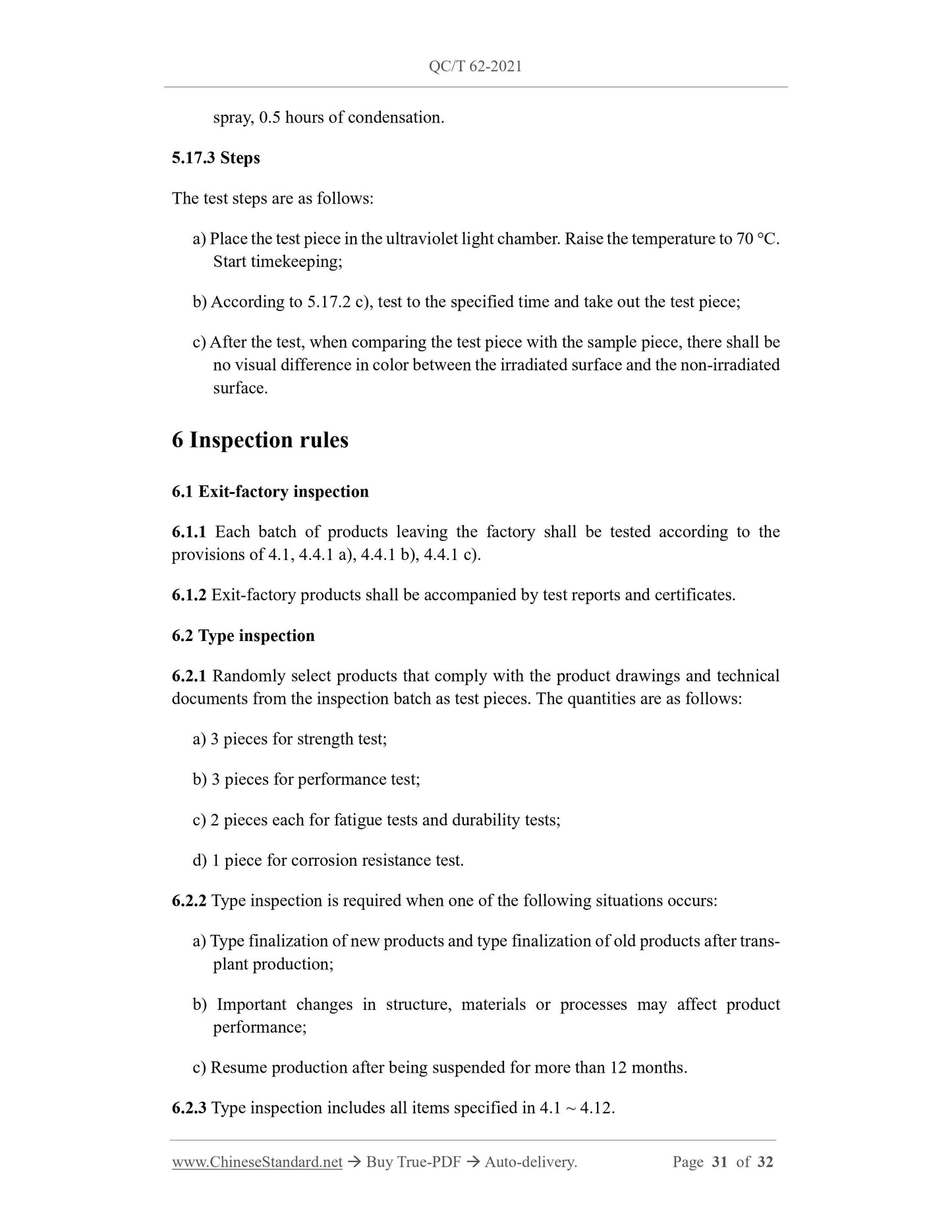1
/
of
11
www.ChineseStandard.us -- Field Test Asia Pte. Ltd.
QC/T 62-2021 English PDF (QC/T62-2021)
QC/T 62-2021 English PDF (QC/T62-2021)
Regular price
$350.00
Regular price
Sale price
$350.00
Unit price
/
per
Shipping calculated at checkout.
Couldn't load pickup availability
QC/T 62-2021: Shock absorber for motorcycles and mopeds
Delivery: 9 seconds. Download (& Email) true-PDF + Invoice.
Get Quotation: Click QC/T 62-2021 (Self-service in 1-minute)
Historical versions (Master-website): QC/T 62-2021
Preview True-PDF (Reload/Scroll-down if blank)
QC/T 62-2021
QC
AUTOMOTIVE INDUSTRY STANDARD
ICS 43.140
CCS T 83
Replacing QC/T 62-2007
Shock absorber for motorcycles and mopeds
ISSUED ON. AUGUST 21, 2021
IMPLEMENTED ON. FEBRUARY 01, 2022
Issued by. Ministry of Industry and Information Technology of PRC
Table of Contents
Foreword... 5
1 Scope... 7
2 Normative references... 7
3 Terms and definitions... 7
4 Requirements... 9
5 Test methods... 14
6 Inspection rules... 31
7 Product marking, packaging, transportation, storage... 32
Shock absorber for motorcycles and mopeds
1 Scope
This document specifies the requirements, test methods, inspection rules, product
marking, packaging, transportation, storage of shock absorber for motorcycle and
moped.
This document applies to shock absorbers for motorcycle and moped, which are
composed of springs, dampers, connectors (hereinafter referred to as shock absorbers).
Shock absorbers without hydraulic damping can also be implemented by referring to
the relevant provisions.
2 Normative references
The contents of the following documents constitute essential provisions of this
document through normative references in the text. Among them, for dated referenced
documents, only the version corresponding to the date applies to this document; for
undated referenced documents, the latest version (including all amendments) applies to
this document.
GB/T 6461 Methods for corrosion testing of metallic and other inorganic coatings
on metallic substrates - Rating of test specimens and manufactured articles subjected
to corrosion tests
GB/T 10125 Corrosion tests in artificial atmospheres - Salt spray tests
GB/T 11379 Metallic coatings - Electroplated coatings of chromium for engineering
purposes
GB/T 1239.2 Cold coiled helical springs technical specifications - Part 2.
Compressions spring
3 Terms and definitions
The following terms and definitions apply to this document.
3.1
Shock absorber
Components composed of springs, dampers, connectors.
4.1.2 The allowable deviation of the free length of the front shock absorber is ±2.5 mm;
the allowable deviation of the free length of the rear shock absorber is ±2.0 mm.
4.1.3 The surface of electroplating layer and coating shall be smooth, flat, uniform in
color.
4.1.4 The weld shall be smooth and uniform; it shall be free of defects such as weld
beading, burn through, slag inclusions, cracks, blisters, spatter.
4.1.5 There shall be no oil leakage from the shock absorber, whether it is placed flat,
upside down or during operation.
4.1.6 During the compression and stretching process, the dampers of front shock
absorber and rear shock absorber shall move flexibly without getting stuck; there shall
be no metal impact sound or abnormal friction.
4.2 Strength
4.2.1 The structural strength of the shock absorber shall meet the requirements of
product drawings and technical documents.
4.2.2 Riveting, folding and sealing, threaded connections, welding and other parts shall
be free of damage or fracture, under the tensile and compressive loads specified in
product drawings and technical documents.
4.3 Spring performance
4.3.1 Accuracy
The spring shall comply with the provisions of GB/T 1239.2.The accuracy level shall
not be lower than level 2.
4.3.2 Static characteristics
The static characteristics of the spring shall meet the following requirements.
a) When assessing the load at a specified height, the deformation shall be selected
within the range of 20% ~ 80% of the assessment stiffness section. The limit
deviation of the spring load is ±8%;
b) When assessing stiffness, the deformation shall be selected within the range of
25% ~ 75% of the stiffness assessment section; the limit deviation of spring
stiffness is ±8%;
c) The static characteristics of the spring are usually assessed based on the load at a
specified height; the stiffness can also be selected. However, the two cannot be
assessed at the same time.
4.3.3 Permanent deformation
After the spring is compressed to the maximum working load for three consecutive
times, its permanent deformation shall not be greater than 0.3% of the free height before
the test.
4.3.4 Fatigue
After the spring is continuously tested for 2 × 105 times at the working stroke, there
shall be no cracks or fractures; its permanent deformation shall not be greater than 2%
of the free height before the test.
4.4 Damper characteristics
4.4.1 Force-displacement characteristics
Damper resistance shall meet the following requirements.
a) The graphics of the force-displacement diagram shall be normal;
b) The compression buffer resistance of the front shock absorber's damper shall not
be less than 200% of the recovery resistance;
c) The resistance tolerance of the damper is as shown in Table 1 and Table 2;
d) If there are special requirements, the resistance at V = 0.1, 0.3, 0.5 (0.6), 0.7, 1.0
m/s shall be tested.
4.4.2 Force-velocity characteristics
The allowable deviation of the resistance of the damper at each specified speed is as
specified in Table 1 and Table 2.
Table 1 -- Resistance tolerance of dampers for ordinary motorcycle shock
absorber at different speeds
Item Front damper / (m/s) Rear damper / (m/s) 0.3, 0.5 0.3, 0.5
Shock absorber of
ordinary
motorcycle
Recovery resistance Ff (N) ± (15%Ff + 20) ± (13%Ff + 20)
Compression resistance Fy (N) - ± (20%Fy + 20)
absorber shall comply with the product drawings and technical documents.
4.6 Gas recoil force
For gas-filled shock absorbers, the gas recoil force Fa shall comply with the product
drawings and technical documents, OR the technical requirements agreed between the
supplier and the buyer.
4.7 Static load characteristics
The vertical (or axial) static load characteristics of the shock absorber shall comply with
the product drawings and technical documents.
4.8 Anti-foam characteristics
During the test, the damper shall not have obvious abnormal noise; the maximum
fluctuation rate of the three measured force-displacement diagrams shall not exceed
25%.
4.9 Cushion pad durability
After the cushion pad is tested continuously for 2×105 times at the maximum allowable
deformation, there shall be no damage, deformation or wear; its load loss rate shall not
be greater than 30%.
4.10 Shock absorber durability
4.10.1 Vertical vibration
Durability during vertical vibration shall meet the following requirements.
a) During the test, there shall be no abnormal noise. After testing 1 × 106 times, the
parts shall be free of damage, deformation, abnormal wear;
b) If a lateral force test is required, the lateral force is 290 N ~ 490 N. After 200 h of
testing, the parts shall be free of damage, deformation, abnormal wear;
c) There is no oil leakage; there shall be no clearly visible oil layer on the surface of
the working section; if test b) is performed, slight traces of oil less than 12 mm
wide can be seen on the surface of the working section;
d) The resistance attenuation rate shall not be greater than 30%.
4.10.2 Drum vibration
The durability of the drum when vibrating shall meet the following requirements.
a) During the test, there shall be no abnormal noise. After 6 × 105 tests, the parts
shall be free of damage, deformation, abnormal wear;
b) Follow the provisions of 4.10.1c).
4.11 Sand, dust, muddy water resistance of dust cover
4.11.1 During the test, there shall be no abnormal noise. After 1×106 test, there shall be
no sand, dust or muddy water entering the inner lip of the dust seal and the lip of the oil
seal.
4.11.2 Parts shall be free from damage, deformation, abnormal wear.
4.12 Surface treatment
4.12.1 For neutral salt spray test (NSS) for engineering hard chromium coating, the 24
h (or 16 h for copper accelerated acetic salt spray test CASS) surface corrosion
resistance shall not be lower than level 8; for the accelerated acetic salt spray test of
decorative chromium coating copper, the 16 h surface corrosion resistance shall not be
lower than level 8; meanwhile it shall meet the requirements of GB/T 11379 and GB/T
6461, OR comply with product drawings and technical documents.
4.12.2 For the neutral salt spray test for colored zinc coating, the 48 h surface corrosion
resistance shall not be lower than level 5; for the neutral salt spray test for white zinc
coating, the 24 h surface corrosion resistance shall not be lower than level 5; meanwhile
it shall meet the requirements of GB/T 6461, OR comply with the product drawings and
technical documents.
4.12.3 After a 48-hour neutral salt spray test on coatings, anodic electrophoretic
coatings, etc., there shall be no corrosion products, blisters, swelling, peeling, or coating
softening along the 3.0 mm of one side of the notch, 6.0 mm in total, OR comply with
product drawings and technical documents.
4.12.4 For the accelerated acetic acid salt spray test of anodized copper coating, the 16
h surface corrosion resistance shall not be lower than level 7; meanwhile it shall meet
the requirements of GB/T 11379, GB/T 6461, OR comply with product drawings and
technical documents. There shall be no difference in color between the irradiated
surface and the non-irradiated surface during the lighting test; OR it shall comply with
the product drawings and technical documents.
5 Test methods
5.1 General inspection methods
5.1.1 Use measuring tools to check dimensions.
5.1.2 Check the appearance visually.
d) Draw the static characteristic curve when necessary;
e) After compressing the specimen to the maximum working load for 3 consecutive
times, measure the free height before and after the test; calculate the permanent
deformation rate.
5.4 Spring fatigue test
5.4.1 Device
Spring fatigue testing machine or shock absorber durability test bench.
5.4.2 Conditions
The test conditions are as follows.
a) Temperature. The test room is at room temperature; the test piece is at room
temperature;
b) Stroke. Working stroke;
c) Frequency. 1 Hz ~ 4 Hz;
d) Number of times. 2 × 105.
5.4.3 Steps
The test steps are as follows.
a) Install the test piece vertically on the test bench (the test piece shall be in a
preloaded state), with approximately one-half of the working stroke as the
midpoint of the test stroke;
b) Operate the test bench and vibrate, according to the specified stroke and frequency;
c) The test shall be conducted continuously without interruption, until the specified
number of times;
d) Measure the free height of the specimen before and after the test; calculate the
permanent deformation rate.
5.5 Force-displacement characteristic test
5.5.1 Device
The test device is as follows.
a) Simple harmonic displacement vibration mechanical or electro-hydraulic servo
test bench, which has a displacement measurement error of less than 0.5% and a
a) Temperature. According to the provisions of 5.5.2 a);
b) Stroke. According to the provisions of 5.5.2 b);
c) Speed. 1.0 m/s.
5.11.3 Steps
The test steps are as follows.
a) According to the provisions of 5.5.3 a), b), c);
b) Start the air cooling device to dissipate heat; operate the test bench to reciprocate
continuously for 100 times according to the specified stroke and speed; record the
force-displacement diagrams of the 98th, 99th, 100th times.
5.12 Test of cushion pad durability
5.12.1 Device
Special test bench.
5.12.2 Conditions
The test conditions are as follows.
a) Temperature. The test room is at room temperature; the specimen is at room
temperature;
b) Stroke. It is determined based on the maximum allowable deformation of the test
piece;
c) Frequency. 1 Hz ~ 2 Hz;
d) Number of times. 2 × 105.
5.12.3 Steps
The test steps are as follows.
a) Install the specimen vertically on the test bench, using the maximum allowable
deformation as the end of the test stroke;
b) Operate the test bench and vibrate according to the specified stroke and frequency;
c) The test shall be conducted continuously without interruption, until the specified
number of times;
d) According to the provisions of 5.3.3 a), b), d), measure the load value of the
c) According to the provisions of 5.13.3 b), c), d);
d) Check that there shall be no sand and dust, muddy water, oil stains inside the dust
seal lip and the oil seal lip of the test piece after the test; there is no abnormal
wear.
5.16 Corrosion resistance test of electroplating layer and coating layer
5.16.1 Device
Salt spray test chamber.
5.16.2 Conditions
It is carried out according to the provisions of GB/T 10125.
5.16.3 Steps
The test steps are as follows.
a) According to the provisions of GB/T 10125;
b) Before the test of the coating specimen, use the tip of the knife to carve a notch
on the main view surface at an intersection angle of about 30° and a depth to the
metal substrate. After the test, use clean water to rinse the specimen. Let it be
standing indoors for 2 hours. Use a 12 mm wide transparent tape (or similar tape),
one end of which is at right angles to the coating surface. Attach it completely to
the notch. After standing it for 1 ~ 2 minutes, quickly tear it off and check the
other portion than the 3.0 mm width on one side of the notch (totaling 6.0 mm),
to see whether there are corrosion products, blisters, swelling, peeling off, coating
softening.
5.17 Lighting test
5.17.1 Device
UV light test chamber
5.17.2 Conditions
The test conditions are as follows.
a) The distance between the lamp and the test piece is 65 cm ~ 75 cm; the distance
between the lamp and the lamp is 20 cm ~ 25 cm;
b) UV lamp 300 W, 400 h;
c) One cycle lasts for 24 hours, including 23 hours of lighting, 0.5 hours of water
spray, 0.5 hours of condensation.
5.17.3 Steps
The test steps are as follows.
a) Place the test piece in the ultraviolet light chamber. Raise the temperature to 70 °C.
Start timekeeping;
b) According to 5.17.2 c), test to the specified t...
Delivery: 9 seconds. Download (& Email) true-PDF + Invoice.
Get Quotation: Click QC/T 62-2021 (Self-service in 1-minute)
Historical versions (Master-website): QC/T 62-2021
Preview True-PDF (Reload/Scroll-down if blank)
QC/T 62-2021
QC
AUTOMOTIVE INDUSTRY STANDARD
ICS 43.140
CCS T 83
Replacing QC/T 62-2007
Shock absorber for motorcycles and mopeds
ISSUED ON. AUGUST 21, 2021
IMPLEMENTED ON. FEBRUARY 01, 2022
Issued by. Ministry of Industry and Information Technology of PRC
Table of Contents
Foreword... 5
1 Scope... 7
2 Normative references... 7
3 Terms and definitions... 7
4 Requirements... 9
5 Test methods... 14
6 Inspection rules... 31
7 Product marking, packaging, transportation, storage... 32
Shock absorber for motorcycles and mopeds
1 Scope
This document specifies the requirements, test methods, inspection rules, product
marking, packaging, transportation, storage of shock absorber for motorcycle and
moped.
This document applies to shock absorbers for motorcycle and moped, which are
composed of springs, dampers, connectors (hereinafter referred to as shock absorbers).
Shock absorbers without hydraulic damping can also be implemented by referring to
the relevant provisions.
2 Normative references
The contents of the following documents constitute essential provisions of this
document through normative references in the text. Among them, for dated referenced
documents, only the version corresponding to the date applies to this document; for
undated referenced documents, the latest version (including all amendments) applies to
this document.
GB/T 6461 Methods for corrosion testing of metallic and other inorganic coatings
on metallic substrates - Rating of test specimens and manufactured articles subjected
to corrosion tests
GB/T 10125 Corrosion tests in artificial atmospheres - Salt spray tests
GB/T 11379 Metallic coatings - Electroplated coatings of chromium for engineering
purposes
GB/T 1239.2 Cold coiled helical springs technical specifications - Part 2.
Compressions spring
3 Terms and definitions
The following terms and definitions apply to this document.
3.1
Shock absorber
Components composed of springs, dampers, connectors.
4.1.2 The allowable deviation of the free length of the front shock absorber is ±2.5 mm;
the allowable deviation of the free length of the rear shock absorber is ±2.0 mm.
4.1.3 The surface of electroplating layer and coating shall be smooth, flat, uniform in
color.
4.1.4 The weld shall be smooth and uniform; it shall be free of defects such as weld
beading, burn through, slag inclusions, cracks, blisters, spatter.
4.1.5 There shall be no oil leakage from the shock absorber, whether it is placed flat,
upside down or during operation.
4.1.6 During the compression and stretching process, the dampers of front shock
absorber and rear shock absorber shall move flexibly without getting stuck; there shall
be no metal impact sound or abnormal friction.
4.2 Strength
4.2.1 The structural strength of the shock absorber shall meet the requirements of
product drawings and technical documents.
4.2.2 Riveting, folding and sealing, threaded connections, welding and other parts shall
be free of damage or fracture, under the tensile and compressive loads specified in
product drawings and technical documents.
4.3 Spring performance
4.3.1 Accuracy
The spring shall comply with the provisions of GB/T 1239.2.The accuracy level shall
not be lower than level 2.
4.3.2 Static characteristics
The static characteristics of the spring shall meet the following requirements.
a) When assessing the load at a specified height, the deformation shall be selected
within the range of 20% ~ 80% of the assessment stiffness section. The limit
deviation of the spring load is ±8%;
b) When assessing stiffness, the deformation shall be selected within the range of
25% ~ 75% of the stiffness assessment section; the limit deviation of spring
stiffness is ±8%;
c) The static characteristics of the spring are usually assessed based on the load at a
specified height; the stiffness can also be selected. However, the two cannot be
assessed at the same time.
4.3.3 Permanent deformation
After the spring is compressed to the maximum working load for three consecutive
times, its permanent deformation shall not be greater than 0.3% of the free height before
the test.
4.3.4 Fatigue
After the spring is continuously tested for 2 × 105 times at the working stroke, there
shall be no cracks or fractures; its permanent deformation shall not be greater than 2%
of the free height before the test.
4.4 Damper characteristics
4.4.1 Force-displacement characteristics
Damper resistance shall meet the following requirements.
a) The graphics of the force-displacement diagram shall be normal;
b) The compression buffer resistance of the front shock absorber's damper shall not
be less than 200% of the recovery resistance;
c) The resistance tolerance of the damper is as shown in Table 1 and Table 2;
d) If there are special requirements, the resistance at V = 0.1, 0.3, 0.5 (0.6), 0.7, 1.0
m/s shall be tested.
4.4.2 Force-velocity characteristics
The allowable deviation of the resistance of the damper at each specified speed is as
specified in Table 1 and Table 2.
Table 1 -- Resistance tolerance of dampers for ordinary motorcycle shock
absorber at different speeds
Item Front damper / (m/s) Rear damper / (m/s) 0.3, 0.5 0.3, 0.5
Shock absorber of
ordinary
motorcycle
Recovery resistance Ff (N) ± (15%Ff + 20) ± (13%Ff + 20)
Compression resistance Fy (N) - ± (20%Fy + 20)
absorber shall comply with the product drawings and technical documents.
4.6 Gas recoil force
For gas-filled shock absorbers, the gas recoil force Fa shall comply with the product
drawings and technical documents, OR the technical requirements agreed between the
supplier and the buyer.
4.7 Static load characteristics
The vertical (or axial) static load characteristics of the shock absorber shall comply with
the product drawings and technical documents.
4.8 Anti-foam characteristics
During the test, the damper shall not have obvious abnormal noise; the maximum
fluctuation rate of the three measured force-displacement diagrams shall not exceed
25%.
4.9 Cushion pad durability
After the cushion pad is tested continuously for 2×105 times at the maximum allowable
deformation, there shall be no damage, deformation or wear; its load loss rate shall not
be greater than 30%.
4.10 Shock absorber durability
4.10.1 Vertical vibration
Durability during vertical vibration shall meet the following requirements.
a) During the test, there shall be no abnormal noise. After testing 1 × 106 times, the
parts shall be free of damage, deformation, abnormal wear;
b) If a lateral force test is required, the lateral force is 290 N ~ 490 N. After 200 h of
testing, the parts shall be free of damage, deformation, abnormal wear;
c) There is no oil leakage; there shall be no clearly visible oil layer on the surface of
the working section; if test b) is performed, slight traces of oil less than 12 mm
wide can be seen on the surface of the working section;
d) The resistance attenuation rate shall not be greater than 30%.
4.10.2 Drum vibration
The durability of the drum when vibrating shall meet the following requirements.
a) During the test, there shall be no abnormal noise. After 6 × 105 tests, the parts
shall be free of damage, deformation, abnormal wear;
b) Follow the provisions of 4.10.1c).
4.11 Sand, dust, muddy water resistance of dust cover
4.11.1 During the test, there shall be no abnormal noise. After 1×106 test, there shall be
no sand, dust or muddy water entering the inner lip of the dust seal and the lip of the oil
seal.
4.11.2 Parts shall be free from damage, deformation, abnormal wear.
4.12 Surface treatment
4.12.1 For neutral salt spray test (NSS) for engineering hard chromium coating, the 24
h (or 16 h for copper accelerated acetic salt spray test CASS) surface corrosion
resistance shall not be lower than level 8; for the accelerated acetic salt spray test of
decorative chromium coating copper, the 16 h surface corrosion resistance shall not be
lower than level 8; meanwhile it shall meet the requirements of GB/T 11379 and GB/T
6461, OR comply with product drawings and technical documents.
4.12.2 For the neutral salt spray test for colored zinc coating, the 48 h surface corrosion
resistance shall not be lower than level 5; for the neutral salt spray test for white zinc
coating, the 24 h surface corrosion resistance shall not be lower than level 5; meanwhile
it shall meet the requirements of GB/T 6461, OR comply with the product drawings and
technical documents.
4.12.3 After a 48-hour neutral salt spray test on coatings, anodic electrophoretic
coatings, etc., there shall be no corrosion products, blisters, swelling, peeling, or coating
softening along the 3.0 mm of one side of the notch, 6.0 mm in total, OR comply with
product drawings and technical documents.
4.12.4 For the accelerated acetic acid salt spray test of anodized copper coating, the 16
h surface corrosion resistance shall not be lower than level 7; meanwhile it shall meet
the requirements of GB/T 11379, GB/T 6461, OR comply with product drawings and
technical documents. There shall be no difference in color between the irradiated
surface and the non-irradiated surface during the lighting test; OR it shall comply with
the product drawings and technical documents.
5 Test methods
5.1 General inspection methods
5.1.1 Use measuring tools to check dimensions.
5.1.2 Check the appearance visually.
d) Draw the static characteristic curve when necessary;
e) After compressing the specimen to the maximum working load for 3 consecutive
times, measure the free height before and after the test; calculate the permanent
deformation rate.
5.4 Spring fatigue test
5.4.1 Device
Spring fatigue testing machine or shock absorber durability test bench.
5.4.2 Conditions
The test conditions are as follows.
a) Temperature. The test room is at room temperature; the test piece is at room
temperature;
b) Stroke. Working stroke;
c) Frequency. 1 Hz ~ 4 Hz;
d) Number of times. 2 × 105.
5.4.3 Steps
The test steps are as follows.
a) Install the test piece vertically on the test bench (the test piece shall be in a
preloaded state), with approximately one-half of the working stroke as the
midpoint of the test stroke;
b) Operate the test bench and vibrate, according to the specified stroke and frequency;
c) The test shall be conducted continuously without interruption, until the specified
number of times;
d) Measure the free height of the specimen before and after the test; calculate the
permanent deformation rate.
5.5 Force-displacement characteristic test
5.5.1 Device
The test device is as follows.
a) Simple harmonic displacement vibration mechanical or electro-hydraulic servo
test bench, which has a displacement measurement error of less than 0.5% and a
a) Temperature. According to the provisions of 5.5.2 a);
b) Stroke. According to the provisions of 5.5.2 b);
c) Speed. 1.0 m/s.
5.11.3 Steps
The test steps are as follows.
a) According to the provisions of 5.5.3 a), b), c);
b) Start the air cooling device to dissipate heat; operate the test bench to reciprocate
continuously for 100 times according to the specified stroke and speed; record the
force-displacement diagrams of the 98th, 99th, 100th times.
5.12 Test of cushion pad durability
5.12.1 Device
Special test bench.
5.12.2 Conditions
The test conditions are as follows.
a) Temperature. The test room is at room temperature; the specimen is at room
temperature;
b) Stroke. It is determined based on the maximum allowable deformation of the test
piece;
c) Frequency. 1 Hz ~ 2 Hz;
d) Number of times. 2 × 105.
5.12.3 Steps
The test steps are as follows.
a) Install the specimen vertically on the test bench, using the maximum allowable
deformation as the end of the test stroke;
b) Operate the test bench and vibrate according to the specified stroke and frequency;
c) The test shall be conducted continuously without interruption, until the specified
number of times;
d) According to the provisions of 5.3.3 a), b), d), measure the load value of the
c) According to the provisions of 5.13.3 b), c), d);
d) Check that there shall be no sand and dust, muddy water, oil stains inside the dust
seal lip and the oil seal lip of the test piece after the test; there is no abnormal
wear.
5.16 Corrosion resistance test of electroplating layer and coating layer
5.16.1 Device
Salt spray test chamber.
5.16.2 Conditions
It is carried out according to the provisions of GB/T 10125.
5.16.3 Steps
The test steps are as follows.
a) According to the provisions of GB/T 10125;
b) Before the test of the coating specimen, use the tip of the knife to carve a notch
on the main view surface at an intersection angle of about 30° and a depth to the
metal substrate. After the test, use clean water to rinse the specimen. Let it be
standing indoors for 2 hours. Use a 12 mm wide transparent tape (or similar tape),
one end of which is at right angles to the coating surface. Attach it completely to
the notch. After standing it for 1 ~ 2 minutes, quickly tear it off and check the
other portion than the 3.0 mm width on one side of the notch (totaling 6.0 mm),
to see whether there are corrosion products, blisters, swelling, peeling off, coating
softening.
5.17 Lighting test
5.17.1 Device
UV light test chamber
5.17.2 Conditions
The test conditions are as follows.
a) The distance between the lamp and the test piece is 65 cm ~ 75 cm; the distance
between the lamp and the lamp is 20 cm ~ 25 cm;
b) UV lamp 300 W, 400 h;
c) One cycle lasts for 24 hours, including 23 hours of lighting, 0.5 hours of water
spray, 0.5 hours of condensation.
5.17.3 Steps
The test steps are as follows.
a) Place the test piece in the ultraviolet light chamber. Raise the temperature to 70 °C.
Start timekeeping;
b) According to 5.17.2 c), test to the specified t...
Share
